Rosa 'Mary Rose' Redux
Saturday, June 02, 2007
Rosa 'Mary Rose' made this blog before on June 20, 2006 but when I saw her yesterday afternoon as I watered the garden I had to bring her in for a scan.
In my early 20s when I was still more nerd-like than I am now I had a beautiful girlfriend in Buenos Aires called, Susy Bornstein. My Irish/Argentine cousins and nephews thought I was "funny" since I always showed up at parties alone. Just for once I was going to make a triumphant entrance with my gorgeous Susy. I chose a rugby game between the Buenos Aires rivals CASI (Club Atlético San Isidro) and SIC (San Isidro Club). My nephew Georgito was a star forward for CASI so here was my chance to show off my manly attraction and prove my family wrong. The fact is that none of my family ever met Susy as she always had an excuse for not showing up. My nephew Georgito had the suspicion that Susy was a figment of my imagination. I was not to learn until recently to make the connection with cats, babies and roses and that is that they never perform on demand.
The most often used excuse by Vancouver rosarians, when someone admires one of your rose bushes is, "You should have seen it yesterday before the rains."
My roses are perfect when I am alone with them in the garden. I smell them and pamper them and remove any leaf that may have a trace of black spot. Roses reduce my tension and stress and some years ago when I suffered terrible migraines I noticed that they diminished in late May and June which are the rose blooming months.
I feel a frustration much as I felt all those years ago that I cannot show off my roses in the same way I could not show off my Susy. I am unable to understand how my intoxication with roses finds no common ground with some of my friends. Even Rosemary sort of ignores my roses and puts her effort into her rather rare perennials. While she will admit that my hostas save the garden in August when none of her perennials have much to offer, she will not come out and tell me that the roses are important in our garden.
It was on Sunday that I went to Crystal Pite's work in progress at the Scotia Dance Centre. Here was a noted international dancer and choreographer giving an intimate performance to four of us. She seemed to be one of my roses. Why was it others did not take advantage of this opportunity (and it was free, too)?
This sheer pleasure that I cannot share brings bouts of loneliness which are most acute on a late and perfect afternoon in the garden as it was yesterday.
It ocurred to me that I have many pink roses. The average person would find them all the same. I have heard people comment on David Austin's roses, "So many of them are pink! They look the same."
But each pink rose when viewed not only for its colour and shape, noticed for the quality and sheen of its foliage or enjoyed for its individual scent, is impossible to confuse, one with another.
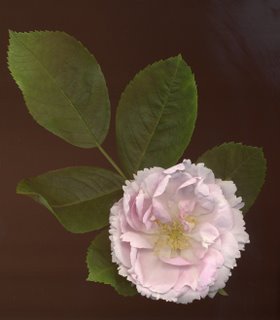
While my Susy was unique, perhaps a one of a kind Rosa 'Fimbriata' (right) who would not glory at showing up at a rugby game with 20 blondes in tow?
Rosa 'Mrs. Oakley Fisher' & The Making Of A Snob
Friday, June 01, 2007
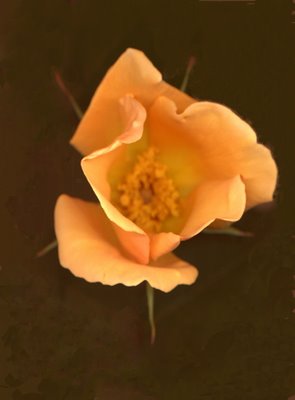
Some 7 years ago I visited eminent Vancouver rosarian Janet Wood at her Southlands garden. I spotted the rose you see here and asked her what it was. I remember distictly saying to Wood, "I am going straight home to make myself a pot of strong Earl Grey, I am going to butter (unsalted, cultured butter) two slices of toast and I am going to spread some apricot jam. I will do all this only after I place my order with you to get me Mrs. Oakley Fisher as soon as you can.
When I was a little boy my grandmother called me "el Príncipe de Gales" because of my uppity tendencies. When she wanted to pursue the matter further she would tell me I had been born to be a prince but somehow I had lost my way. My mother, all her life, would look at me and say, "Hay poca gente fina como nosotros." That losely translates to, "There are few people of breeding like us." My grandmother was a coloratura soprano but never sang professionally because people of her social standing never did stuff like that.
And so I have been saddled all my life with, "Naciste para príncipe, pero te quedaste en el camino."
How was I to know that my New Dublin born wife, Rosemary Healey, whose father was a carpenter would be just as uppity? And nowhere does this manifest itself more than in our garden. I have written here before how only recently did Rosemary allow me to have orange and yellow in the garden (all, of course, with moderation). But it was Rosa 'Mrs Oakley Fisher' that brought down the yellow barrier for her and she feels as much affection for this single (five petals) hybrid tea rose as I do.
Most of the roses in our garden were recommended by Janet Wood (seen here holding Rosa 'Dainty Bess' a classy single hybrid tea, with Dennis Yeomans, a Chilean born Vancouver rosarian who writes about roses exquisitely). Her easy going, down-to-earth manner does not readily reveal that she has not only a good eye for roses but she also has a bit of my mother's "gente fina". She has very good taste for roses.
It is most fashionable to have old roses or English roses in the garden. It is fashionable to have obscure gallica's and hybrid musks. These I have. But a true garden snob will have one hybrid tea rose. It has to be Rosa 'Mrs Oakley Fisher', of course.
She was bred by Colchester rose man Benjamin Cant in 1921. The specimen you see here I brought in from the garden this morning to scan.
The Making of a Snob- Part II
Antonio & Ramón de Irureta Goyena
Thursday, May 31, 2007
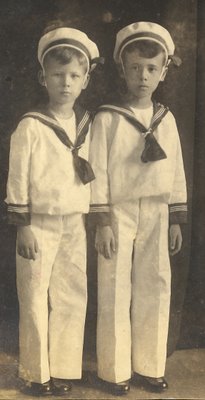 Rosemary returned on Tuesday night from a trip to visit her older sister Ruth near New Dublin, Ontario. The town where both of them lived, New Dublin is now almost a ghost town. The church and school were closed and the few children that remain are bussed to school. Not surprisingly, the cemetery, with beautifully old tombstones from the 18th century is kept up. Memory for those we long ago forgot is kept alive while the owners of Rosemary's ancestral home would never know that Rosemary's father, Frank, built it from scratch. It was a sad occasion for Rosemary to drive by her old house. We had a garden barbecue yesterday and the Waterhouse-Haywards (Rosemary and Ale) and the Stewarts (Hilary, Bruce, Lauren and Rebecca) came. It was a beautiful evening and after we ate, Rebecca, Lauren and Ale had sword fights with paper towel cores. Meanwhile Hilary grilled Rosemary about her trip and enquired about her cousins. Rosemary had brought old photographs (many were some of the first colour prints I had printed some 30 years ago) and stuff that Ruth had kept. Rosemary did not bring her mother's recipe books and Hilary who is a keen cook was adamant that she wants them. It was here that Ale hit me brutally without knowing it. But I am so glad she did. She said, "Yes let's get those recipe books. We don't want people to look at them and wonder what they are." In my head I saw a garage sale with a pile of recipe books that would be purchased a few at a time by innocent but interested buyers. Somehow the memory of Rosemary's mother would be furthed diluted by it. And yet except for the powerful or the notorious who can build monuments for their remembrance or for the impetuousness of Achilles who will always be remembered in having snubbed King Agamemnon it is our fate to be forgotten within a couple of lifetimes. Antonio (left) and Ramón (right) de Irureta Goyena were half brothers of my grandfather don Tirso de Iruteta Goyena. Everybody always noticed that I was the spitting image of Antonio. I may be the last person to know who Antonio was (but I will never know what became of him). Some day this photo just might be looked at by one of my decendants who will not know anything but perhaps smile at the curious sailor suits. As long as I remember for a while (after having anticipated and then enjoyed it all yesterday) that Rebecca, Lauren and Ale had their sword fights in the beauty of our garden, nothing else really matters.
A Beautiful Aberration
Wednesday, May 30, 2007
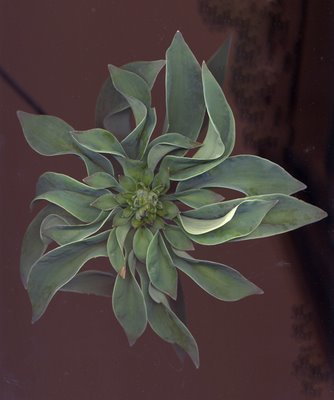
Hostas are generally prized for their leaves, particularly when they are variegated. Not many notice hosta flowers some of which can be extremely fragrant. Some flowers are striped and some are beautiful before they even open as they look like the beaks and heads of exotic oriental birds. The flowers of Hosta clausa are notable in that they never open.
I love hostas and spend time placing them so that they will look their best. If you plant a blue hosta next to a gold hosta the gold hosta will look golder and the blue one bluer. But hostas are not really blue or gold. The blue ones as defined by W. George Schmid in his The Genus Hosta
Blue-green (enhanced by temporary surface effects). A dull green passing into greyish blue, usually associated with a glaucous, caesious, pruinose, or glaucescent surface.
Some people believe that the "blue" coating of blue hostas (sometimes called the bloom) protects the plant from the harsh UV rays of the sun. Many blue hostas originated in the high mountain areas of Japan. This blue coating reflects UV in the same way as sun block does. When you photograph a blue hosta (specially in the shade with the added blue of shade) it will look an unnatural blue. The reason is that both film and digital cameras are more sensitive to UV than we humans are.
Hosta 'Buckshaw Blue' is one of the bluest of my blue hostas. It has white flowers. By the beginning of June the leaves are a startling blue-green. This year Buckshaw Blue surprised me with a vegetative aberration (hosta experts are not sure why hostas do this) that is a combination of a large hosta flower with extra thick, small and narrow leaves. The whole structure which I would call a rosette is 8 inches across.
Blue hostas remain blue longer in our cooler climates. In the south of the US with their hot and humid climate the bloom disappears by the end of June while in Vancouver the colour persists well into August. It is not polite to touch a blue hosta as touch will leave a blemish and you will never be invited to that garden again.
Addendum by W. George Schmid
As you do, I like those large crowns of bracts (a true bract is protective leaf covering usually associated with a developing flower). Bracts is what I call these scape/raceme leaves. You must have had more rain than normal. During very wet weather, the bracts sometimes grow larger and become leaf-like and get way ahead with their growth process before scape/raceme elongation separates the bracts longitudinally and the "crown dissolves." In the fold of each of the upper bracts hides a flower and that is why they are called fertile bracts. These fertile bracts may be joined by several bracts emerging below the fertile bracts. These do not have a flower hiding in the "wings." They are sterile bracts, sometimes called bracteole. As stated above, the whole leafy menagerie is occasionally way ahead of scape/raceme elongation and flower development and so grows into a leafy cluster. The right genetic background also helps in the development of these flamboyant bud covers (looking much like a leafy crown), to wit, one of its grandparents (in the H. sieboldiana/ H. ' Tokudama' group) regularly goes though a stage in its growth cycle, when the bracts form a similar leafy crown, but not as exaggerated as the one seen in your picture. Other hostas also form these leafy structures, like the one (shown on plate 138 of my book) on H. 'Undulata'). Enjoy it when and while you can, it may not develop this way next year. I love Nature, it is so much more entertaining than TV.
Greetings from the very dry South, George
W. George Schmid
Hosta Hill R. G.
USDA Zone 7a - 1188 feet (361m) AMSL
84-12'-30" W 33-51' N
Rosa 'Hansa' - Alexandra Elizabeth
Tuesday, May 29, 2007
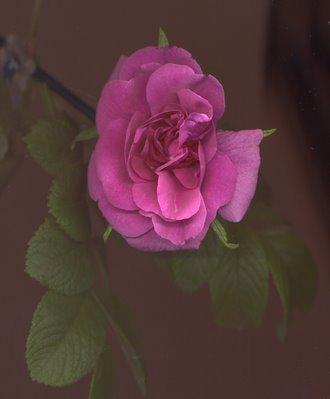 The Hanseatic League was an alliance of trading guilds that established and maintained a trade monopoly over the Baltic Sea, the North Sea, and most of Northern Europe for a time in the Late Middle Ages and the early modern period, between the 13th and 17th centuries. The member cities where either called Hanseatic cities or Hansa cities. The German automobile company, The Borgward Group made cars called Hansas and the beautifully named Borgward Isabella and Arabellas of the 50s and 60s. They also made a Hansa 1100 that was efficient looking (the kindest word I can cook up). I remember it in the streets of Mexico City in the early 60s. The company went bankrupt in 1961 and for a while Mexico built Borgwards in the middle 60s. In one of the contemporary rose bibles, Classic Roses - Peter Beales, Beales describes Rosa 'Hansa': Schaum and Van Tol Holland 1905
Very free flowering. Double, highly scented, reddish-purple flowers. Vigorous, medium-sized plant with dark green foliage. Excellent red fruit. This is one of the best all-round Rugosas.When my daughter gave me this rose three years ago I wondered why she had not picked (if it was to be a hybrid rugosa) a rose with a name like Lady Curzon, Sir Thomas Lipton or even Jens Munk. Hansa? That's not a name to slip one into nostalgic romance. But some further investigation into my memory (those Hansa cars in Mexico) and a little thought about the Hanseatic League convinced me that Schaum and Van Tol of Boskop had a legitimate reason to call such a beautiful rose by that deceptively mundane name. Enterprising and forward looking Dutch cities had been members of the League. Much in the same way that in yesterday's posting I played the game of equating a plant/flower to my daughter Hilary I began to think of which one reminded me of my other daughter Alexandra Elizabeth (Ale, pronounced as in Alexandra after removing the xandra). What is readily evident is that the plant that reminds me of Ale picked me and not the other way around. And that is the way that it should be. From the very beginning Ale was an independent soul and when her sister came along we dedicated a lot of time and attention to the more clingy Hilary. It is only many years later that as parents we realized that independent children need as much attention even if they don't ask for it. It is for this reason that Ale is more of a mystery to me than Hilary. But she is efficient and dependable when efficiency and dependability are called for. In this way she is Rosa 'Hansa'. Rosa 'Hansa' is a cast iron rugosa and like all cast iron rugosas it will bloom with no care, in poor soil and adverse conditions. And rugosas are healthy and resent the care of sprays of any kind. In the first year Hansa did not bloom even though I fertilized her and gave her water and all the care I could. Could Hansa be as unpredictable and independent as Ale is? I believe so. Ale tends to dress in understated ways and buys most of her clothing at the Sally Anne. You just might not notice her. But every once in a while, she will dress up and with the exquisite manners and bearing she inherited from my mother she will take your breath away in the same way Hansa did this morning when I noticed her colour and her scent.  Hansa's scent cleared my memory of smells like my breakfast tea and bread, like a scrub brush. The perfume went to my brain like a laser. Yesterday afternoon Ale was my left hand as I photographed a woman for the Reader's Digest on Granville Island. Her efficiency with my equipment while at the same time making my subject relax reflects her multi talents. We are upset that she is abandoning her Vancouver teaching career for the uncertainty of Lillooet, B.C. where she will live on an acre in a little house, Rosemary says is a shack. The weather is one of extremes as it is a zone 4. Ale, who has several green thumbs will have a more restricted pallette of plants to chose from. But like Rosa 'Hansa' she will prosper (rugosas do just fine in zone 4). The only problem to be resolved is: Where will I find a Hansa to give to Ale?
Hilary - That Cheerful Welsh Poppy
Monday, May 28, 2007
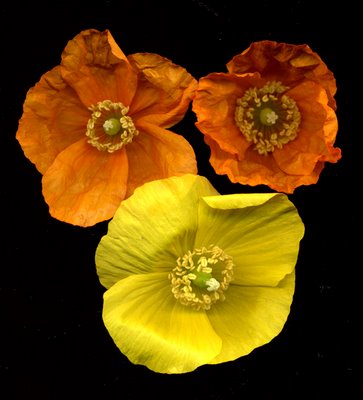 The Welsh poppy (Meconopsis cambrica) is a perennial plant of the family Papaveraceae. Its habitat is damp shady places on rocky ground, and it is native to south-western England, Wales, Ireland and Western Europe. In its most western locations, it is increasingly found on more open ground with less cover. The Welsh poppy (Meconopsis cambrica) is a perennial plant of the family Papaveraceae. Its habitat is damp shady places on rocky ground, and it is native to south-western England, Wales, Ireland and Western Europe. In its most western locations, it is increasingly found on more open ground with less cover.
It has pinnately divided leaves. The flower is distinctively yellow or orange with four petals, and hairy green sepals that fall off quickly after the flower opens. It spreads easily from the numerous small black seeds produced in the summer. It is especially well adapted to colonising gaps and crevices in rocks and stones. This habit has enabled it to colonise the urban emvironment, growing between paving slabs and at the edges of walls.The above little essay from Wikipedia deftly hides the fact that the Welsh poppy is a weed. When we arrived at our present home in 1986 Rosemary pulled this poppy wherever she saw it growing, in spite of the fact that Meconopsis cambrica previously known as Papaver cambrica ) is one weed that cheerfully lives and lets live. Rosemary's attempts at eradication failed somewhat as the cheerful little flower is back. Rosemary is far more forgiving about yellow and orange flowers now. At one time, as soon as our large clumps of Iris pseudacorus (yellow flag iris) showed hints of yellow buds, Rosemary snipped them off. Perhaps she has less time now or she has come to accept that yellow isn't all that bad. I have always valued the function of epicene names. These are names that don't readily reveal the person'sex. It is up to the person to define and make the name their own. And this is what my daughter Hilary has done, and she has done it well indeed. Hilarius or Hilary (ca. 300 – 367) was bishop of Poitiers and I have no idea if the patron saint that protects us from snake bites was hilarious or cheerful in any way. His life was changed when he read the scriptures verse where God tells Moses "I AM WHO I AM" (Exodus 3:14), St. Hilary said, "I was frankly amazed at such a clear definition of God, which expressed the incomprehensible knowledge of the divine nature in words most suited to human intelligence."  Hilary is cheerful and most steadfast as to who she is. I distinctly remember her telling me some years past when I criticized her for some action, "I am who I am and if you don't like it well then...." Just like those Welsh poppies, that are so much like her, she asserts her presence, and lives and lets live.
A Quirky Crystal
Sunday, May 27, 2007
 Today at 3:30 I will be enjoying (a privilege, really) of watching Crystal Pite dance in a work in progress. Not too many get invited to this sort of thing. I am lucky. The quirky Pite posed with some friends from Ballet B.C. here, below. Only Pite would suggest to not face the camera. 
|


















